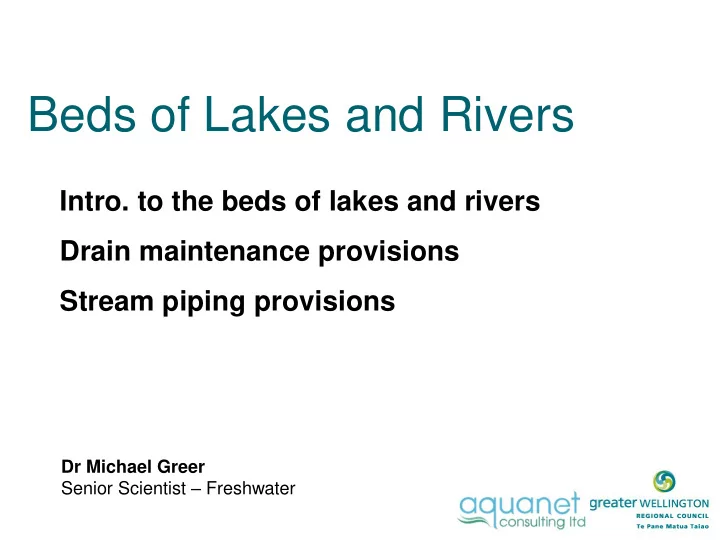

Beds of Lakes and Rivers Intro. to the beds of lakes and rivers Drain maintenance provisions Stream piping provisions Dr Michael Greer Senior Scientist – Freshwater
Intro. to the Beds of Lakes and Rivers
The importance of the bed • The bed determines habitat availability and quality • Important components of the bed include: – Substrate, size, composition and diversity; – The number and size of habitats types; and – The availability of woody debris • Policy P31 aims to protect important functions of the bed
The importance of the bed • Modifying the bed can affect ecosystem health even when water quantity and quality are pristine
Main threats to the beds of lakes and rivers • River control; • Drain clearing; • Piping; and • Structures that block fish passage
The need to protect the beds of all river types • Rivers and streams are different, so are they values they support
The need to protect the beds of all river types • Rivers and streams are different, so are they values they support • Maintaining regional biodiversity requires the protection of all river types, including headwater streams and drains
Drain maintenance provisions
Value of “drains” • Often support biodiversity comparable to “natural” streams • Used by most migratory fish species, and support >20 native species, including several that are threatened • Make up at least 10% of NZ streams, and a lot of the streams in the Southern Wairarapa
Value of “drains” 1962 2017
Value of “drains” With drainage Without drainage
Effects of clearing • Stranding of fish and invertebrates • Suspended sediment • Deoxygenation • Habitat destruction
Stranding • Up to 20% of fish may be removed during clearing • Most stranded fish, including eels, die – Trapped in spoil – Dry out – Eaten by birds
Sediment • Massive increases that can last for months • Interferes with fish feeding, breeding, breathing and migration • Smothers invertebrates and their habitat
Deoxygenation • Suspension of sediment can deoxygenate water for days • Results in large fish kills
Habitat destruction • Plant cover removed • Bed and banks smoothed • Pool-run-riffle sequence lost • End result = fish and invertebrate habitat reduced
Technical basis for clauses (R21) e) Sediment condition of Section 5.5.4 of the proposed Plan excluded as it generally will not be met f) To reduce detrimental changes to the shape of the bed and banks g) To reduce the rate at which fish and invertebrates are stranded during clearing (current wording to prescriptive) To reduce mortality rates of fish and kōura removed h) from drains during clearing
Technical basis for clauses (R21) i) To reduce the risk of the sediment removed from drains during clearing re-entering the waterway j) To ensure that refuge areas are provided in cleared reaches, so that fish and invertebrates do not have leave in order to find cover k) To ensure that short sections of plants are left at the downstream end of cleared reaches to trap sediment (does not currently achieve this)
Improvements to clauses (R21) f) Allow for deepening and widening of the channel to allow construction of artificial fish refuge structures (links to j) g) Should be deleted as it may be detrimental in some instances Should be amended to ensure that kākahi h) (freshwater mussels) are also recovered from spoil during drain clearing operations
Improvements to clauses (R21) i) Could be improved by ensuring that spoil is placed in a way that allows trapped fish and kōura to make their own way back to the stream j) Could be improved by providing alternatives to the partial clearance: – Retention of entirely un-cleared sections at regular intervals along the targeted reach; and – the construction of fish refuge bays
Improvements to clauses (R21) k) Could be improved by: – Stipulating that to minimise downstream sediment transport, an un-cleared section of aquatic plants should be left at the downstream end of cleared reaches – Allowing for a range of different methods to be used to trap sediment released during drain clearing operations
Stream reclamation provisions
Extent of piping • The Kumutoto, Pipitea, Tiakiwai, Tutaenui, Waipiro, and Waitangi streams all piped
Extent of piping • The Kumutoto, Pipitea, Tiakiwai, Tutaenui, Waipiro, and Waitangi streams all piped • 12.79 km piped between 2003 and 2008 • 2.4 km of piping allowed under just three consents since notification • Headwater streams most affected
Value of headwater streams • The character of a river reach is determined by the state of all the tributaries upstream, including small headwaters • Headwaters: – Are a key source of food in downstream environments – Regulate downstream water quality – PROVIDE HABITAT…
Value of headwater streams • The character of a river reach is determined by the state of all the tributaries upstream, including small headwaters • Headwaters: – Are a key source of food in downstream environments – Regulate downstream water quality – PROVIDE HABITAT…
Headwater streams & habitat • Important contributors of habitat quantity • Likely make up at least 50% of stream length in the Wellington Region
Headwater streams & habitat • Habitats provided by headwater streams differ based on: – Hydrology; – Morphology; and – Riparian cover • Headwater streams provide diversity at the regional, catchment and stream scale
Headwaters as contributors to biodiversity • Habitat diversity among headwaters = high invertebrate diversity • Headwaters supports different macroinvertebrate communities to the larger waterways downstream • In the Wellington Region headwater streams contribute to overall regional biodiversity
Effects of piping • Degrades habitat and reduces food availability, thereby decreasing species diversity and abundance • Reduces water quality and increases flood risk downstream • Can impede fish passage • Cumulative effects
Effects of piping • Degrades habitat and reduces food availability, thereby decreasing species diversity and abundance • Reduces water quality and increases flood risk downstream • Can impede fish passage • Cumulative effects
Recommend
More recommend